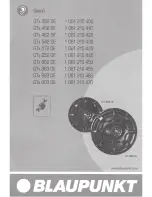
Installing and connecting the loudspeakers.
When choosing a suitable location for the monitors, bear in mind that the physical
mounting of loudspeakers can have a large influence on performance. For best
results the monitors should be mounted on a rigid structure, supported on four pads
making contacts with the laminated panel. The use of soft pads (rubber, Sorbothane,
etc..) is recommended.
When used in the landscape orientation, we recommend location of the monitors so
that the drive units are toed inwards, with their axes oriented towards the listening
position. The distance between the two speakers should be about 1.5 to 2 metres,
depending on the monitoring position. The distance between the monitoring position
and each speaker should be slightly greater than the distance between the speakers.
If the speakers are placed too close to each other the full stereo image may not
develop, on the other hand if you place them too far apart you will notice an audible
hole in the middle of the stereo image.
Ensure that the console position does not obscure the direct sound radiation from the
Dual Concentric drive unit when sitting down. The engineer and producer should
have a clear, uninterrupted view of the monitor loudspeakers.
Connection to the amplifier is made by means of a pair of banana sockets, located
on the termination panel at the back of the speakers. When connecting the speakers
it is essential that consistent polarity is observed. The red terminal on the
loudspeaker must be connected to the red or positive terminal on the power
amplifier, and the black terminal on the loudspeaker must be connected to the black,
negative or ground terminal of the power amplifier.
The types of cable used to connect the speakers to the power amplifier will
marginally affect the sound. The cross-section area of the cable should be large
enough not to affect the damping factor, and generally a cable of 2.5 mm², or
greater, cross-section can be recommended.
Before connecting the amplifier and the monitors, it is advisable to ensure that there
is no signal present either by turning amplifiers gain down or by setting the output
faders.
Power amplifiers.
The power amplifier should be reasonably well matched in power to the power rating
of the speakers. A recommended range of power can be found in the specifications
(at the end of this manual). The use of a powerful amplifier (i.e. the higher figure of
the specified power range) provides headroom which is useful especially for highly
dynamic programme materials.
Because of the high peak power handling of the Tannoy monitors, a responsible use
of even more powerful amplifiers should not represent a danger for the speakers if
the amplifiers are not overdriven.
Содержание System 800
Страница 1: ...System 800 USER MANUAL...
Страница 8: ...CURVES Figure 1 On axis anechoic response Figure 2 Impedance...
Страница 11: ...For Tannoy Ltd...






























